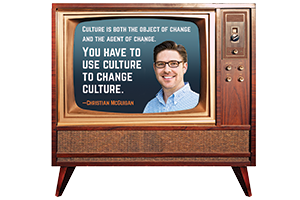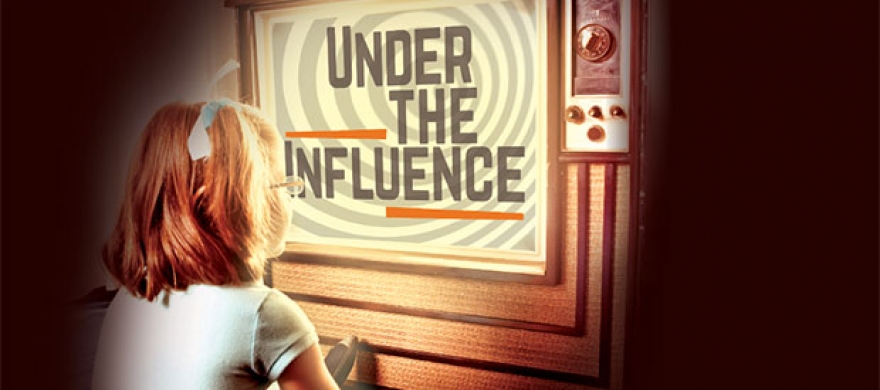Under the Influence
A professor reveals how new societal norms and government regulations are formed through strategic and scientific uses of airtime
Teenagers hate being lied to, taken advantage of, and bossed around by adults. And according to research, they sometimes turn to cigarettes as a form of rebellion against conformity and discipline.
That is why anti-smoking campaigns had consistently floundered for decades until the
“truth” anti-tobacco campaign that launched in the late 1990s, when television executives
finally realized that national commercials featuring adults telling kids to avoid
cigarettes were completely counterintuitive. Instead, they redesigned the ads to focus
on teens addressing their peers, informing them that tobacco companies were deceiving
them and implementing strategies that were oppressive to minorities. When the teenage
smoking rate dropped dramatically following the launch of the reimagined ads, the
“truth” campaigners discovered the power and influence of their new strategy.
This example of the media’s tactical approach to changing social norms is one of many
that professor Christian McGuigan explores in his Media and Social Impact course at
the School of Public Policy.
“If you’re looking at what can play a major role in influencing public policy in any
given time period, it’s culture and how culture changes,” he reveals. “Culture is
both the object of change and the agent of change. You have to use culture to change
culture.”
According to McGuigan, the road to a major cultural shi and new public policy measures
o en begins with the prominence of entertainment media, primarily due to the large
audience that television, film, and digital media (including social media) draw. The
entertainment media space can also be vastly influenced by a relatively small number
of individuals, which helps generate a large following for their endorsements.
But how exactly do these influential figures use media to promote cultural change?
Scientific research indicates that inspiring empathy and prompting subsequent action
is induced through e ective storytelling. THE SCIENCE OF STORYTELLING
THE SCIENCE OF STORYTELLING
A study spearheaded by Paul J. Zak, a psychology and economics professor at Claremont
Graduate University, suggests that the human brain produces the neurochemical cortisol
(commonly known as “the stress hormone”) when audiences engage in entertaining and
relatable narratives.
“Cortisol tells us to pay attention if the story is engaging and really grabs our
attention,” McGuigan explains. “When that happens, through the synthesis of another
neurochemical, oxytocin (the “bonding hormone” responsible for creating deep emotional
connections), the audience will begin to self-identify and empathize with the characters
to the point where they start to experience similar emotions. That is the reason we
bond with certain characters and why e ective stories can actually move us.”
The study found that when both male and female audiences connected with a character
in an engaging story, their brains produced such high levels of oxytocin that the
neurochemical persisted long a er viewing the content.
“Our brains are hardwired to process information in a narrative form,” McGuigan shares.
“So when people say they were changed by a story or that a story changed their perspectives,
it really did change them. It changed their brain chemistry.”
TEACHING THROUGH TELEVISION
Emotional connections to quality content can thus drive the general public to take
action in a way that is relevant to the story they just watched. A notable example
of one such influential storyline is that of “the designated driver.” In 1988 the
Harvard T. H. Chan School of Public Health devised a national communications plan
to decrease the number of alcohol-related vehicular homicides. At the time, the trite
“Don’t Drink and Drive” campaign was proving ine ective with the target demographic
of young adults between the ages of 15 and 24. As with early anti- smoking campaigns,
merely telling people to avoid a specific action was very evidently not working.
Those involved in the Harvard study modeled their project a er a similar campaign
that had proven successful in several Scandinavian countries, which introduced the
concept of “the designated driver.” Instead of recommending that people not drink
and drive, the new message was to ask the public to take a break from drinking just
one night a week and to volunteer as the sober driver for their group of friends.
In determining how to scale this call to action and reach the widest possible audience,
the researchers met with studio executives to discuss integrating designated driver
storylines into network television. Within four years, over 160 prime-time television
shows, including Cheers andThe Cosby Show, had incorporated this narrative into their scripts.
“In addition to their traditional programming, the major networks all worked together,
aired various public service announcements related to the designated driver, and were
able to successfully introduce this concept to the wider American public,” McGuigan
notes.
“If you can have that blanket awareness within your target demographic, then there’s
an opportunity to start inspiring some kind of personal behavior change. And if you
can get that personal behavior change at scale, then you can start to see social change.”
A CALL-TO-ACTION FILM
McGuigan has tested the validity of this research in his own life as well. As the
former vice president of integrated content strategy at film production company Participant
Media, he developed a social impact campaign around the 2011 global water crisis documentary
Last Call at the Oasis. His plan was to create a call to action that motivated Millennials to pledge to
reduce their water footprint in their everyday lives, specifically by making mindful
decisions about purchasing food and clothing that require excessive water to produce.
In order to expand their potential impact, McGuigan and his team established a partnership
with the National Geographic Society and the Bonneville Environmental Foundation,
as well as with several corporate partners who funded the project. The partners agreed
that for every pledge received, one thousand gallons of water would be reallocated
to the Colorado River.
Part of the strategy was to continually educate people about their water footprint
a er they had made the pledge, sending them biweekly texts with facts, updates, and
quizzes about how their new water-conscious choices are improving the earth and helping
the Colorado River. To date, the nearly four-year-old project—which is tracked via
the website changethecourse.us—has restored about 240 million gallons of water to
the Colorado River through 240,000 pledges. McGuigan credits the campaign’s success
to strategic external partnerships.
“When a brand wants to do something in the social-good space, it is o en beneficial
to work with a nonprofit partner. While a nonprofit has great solutions for resolving
issues in the political or social realms, they o en lack the scale, audience, and
funding that a brand can provide,” he explains.
“If you’re a brand or foundation, you might have the scale or the reach, but you have
a difficult time breaking through the daily noise in media in a legitimate way. That’s
where you have a feature film, documentary, television show, or digital series that
allows you to cut through the noise and reach your target audience in a way that you
can’t with any other piece of content.”
McGuigan is continuing this work today as vice president of content strategy at Cone
Communications, an insight-driven and idea-led integrated marketing agency known for
igniting brands with high-impact strategies and programs that help clients achieve
both business and societal outcomes.
SOCIAL MEDIA AND SOCIAL JUSTICE
In addition to television and film, McGuigan examines the power of digital content
through the political e orts of the Harry Potter Alliance—a group of predominantly
young people that comprise about 250 chapters globally, who joined together based
solely on their fandom of the Harry Potter book series.
After gaining a substantial following, the group decided to use its influence and
love of Harry Potter for social change by raising awareness around issues that are germane to the spirit
of the titular character. The group discovered, for example, that the chocolate used
inHarry Potter-themed candy frogs sold by Warner Bros. (who owns the eight-film franchise) was not
sourced from fair trade farmers and may have involved child slavery.
In order to gain traction and demand action from Warner Bros., the alliance launched
a massive international campaign entitled “Not in Harry’s Name” to influence the media
conglomerate to start sourcing fair trade chocolate for the frogs. Their campaign
included user-generated videos and petitions, and advocates began to source their
own fair trade chocolate frogs simply to prove to Warner Bros. that ethical production
was possible.
The author of the fantasy series, J. K. Rowling, also recognized the campaign and
suggested to Warner Bros. that the appropriate executives meet with Harry Potter Alliance
cofounder Andrew Slack to discuss potential solutions. The conversation eventually
took place, and a er a four-year battle Warner Bros. agreed to start using fair trade
chocolate in their frogs.
“We see these moments of major attention in cultural change, but it can take a significant
amount of time to actually establish a new normal,” McGuigan contends. “So although
sometimes it can take decades, it could also be accelerated in the 21st-century media
landscape.”
FROM BOARDROOM TO CLASSROOM
In exploring these concepts and strategies in the classroom, McGuigan notes that prior
to his professorship at Pepperdine when he was a guest lecturer at the School of Public
Policy, some students already seemed to have a solid understanding of the ways in
which culture influences the development of public policy.
Student Adlah Chisti, who is already on the path toward a career in government and
politics in Washington, DC, has found McGuigan’s examples of cultural influence on
political matters particularly intriguing and beneficial.
“This class o ers great insights on how culture and media can influence policies themselves,
depending on how they are ‘packaged’ for public consumption,” she shares. “This is
important because sometimes state and federal governments have inadequate tools in
promoting or advocating policies.”
As McGuigan explains, that is why those who are in the culture-change business tap
into film, television, digital media, and strategic partnerships to achieve change.
“Whatever these graduate students end up doing in the public policy world, having
this background and understanding of how media influences culture and culture influences
public policy could help influence their career path, especially if they are trying
to achieve something groundbreaking in that space.”
